A basic metaphor is a figure speech that makes a hidden, in plain sight, comparison between two things or concepts. In most cases, the comparison is seen as contradictory that focuses on a single commonly held characteristics. The following collection of activity sheets will teach your students how to identify and interpret metaphors. Activities include rewriting prompts as metaphors, defining metaphors, identifying comparisons, transforming similes into metaphors, and more. Answer keys have been provided for instructors, but note that in some cases, student answers will vary. Fun Activity: While authors and speakers should try to avoid mixing metaphors, they can be fun. Have your students try to come up with good ones, such as "We'll burn that bridge when we come to it."
Print Metaphor Worksheets
Click the buttons to print each worksheet and associated answer key.

The Road Not Taken
Two roads diverged in a yellow wood, And sorry I could not travel both And be one traveler, long I stood And looked down one as far as I could To where it bent in the undergrowth. What is the primary concept at work in the poem?

Understanding Metaphors
The metaphors in each picture below are very similar. Study the picture and read the sentence. Using what is happening in the picture as a clue, explain each metaphor.

Translating
A metaphor is a kind of figurative language that is a direct comparison between two unlike things. You can tell the difference because a simile uses the words "like" or "as." Metaphors are often constructed using the verb "to be."

To Compare Things
Underline the metaphor in each sentence below. Then identify the two things that are being compared.
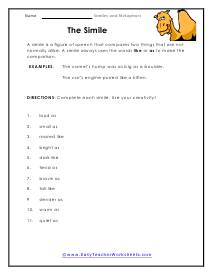
The Simile
A simile is a figure of speech that compares two things that are not normally alike. A simile always uses the words like or as to make the comparison.
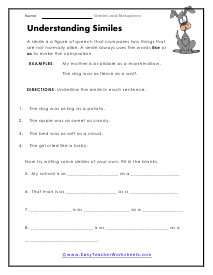
Understanding Similes
Examples: My mother is as pliable as a marshmallow. The dog was as fierce as a wolf. You will look at a series of examples and then write your very own.
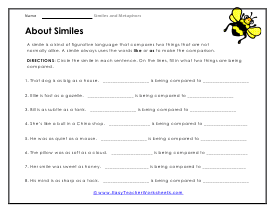
How About It?
Circle the simile in each sentence. On the lines, fill in what two things are being compared.
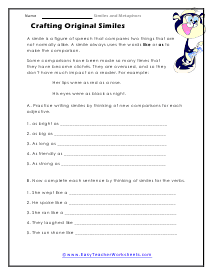
Crafting Originals
Practice writing similes by thinking of new comparisons for each adjective. Also complete each sentence by thinking of similes for the verbs.
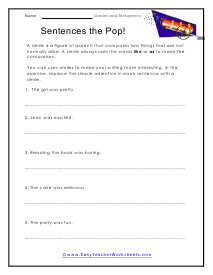
Sentences the Pop!
You can uses similes to make your writing more interesting. In this exercise, replace the simple adjective in each sentence with a simile.
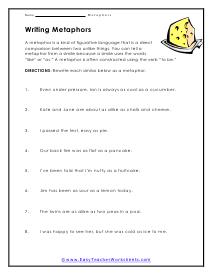
Writing Metaphors
Rewrite each sentence and create your own awesome meaning. The more creative, the better!
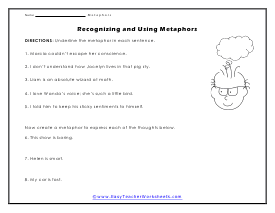
Recognizing and Using Metaphors
Underline the metaphor in each sentence. Create your own way to express each of the thoughts below it.

Location, Location
Read the passage. Underline all of the metaphors that you find them hanging out and adding color to the language.
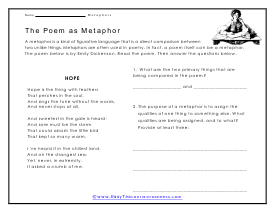
The Poem as Metaphor
Read the poem. Then answer the questions below. This will open your eye as to the similarity between the two.

Is That One?
See how far you have gotten with this skill. This is perfect for seeing where you may be at with it.

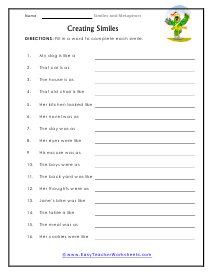
Thoughtfulness
Fill in a word to complete each simile. You will finish off all of the sentences that you are going with.
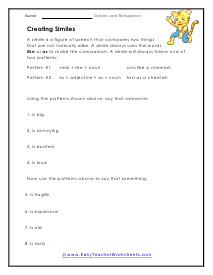
Verbs + Adjectives
Using the patterns shown above, say that someone some physical or mental quality.
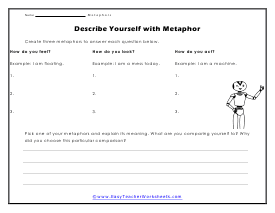
Describe Yourself
How do you feel? How do you look? How do you act? Put into colorful language for your readers.
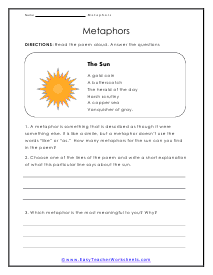
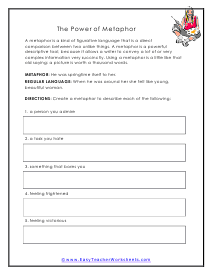
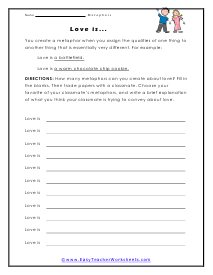
Love is...
See how many different ways you can express the concept of love? Fill in the blanks. Then trade papers with a classmate.
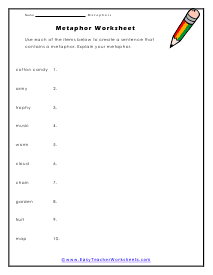
Write em' Up
Piece all of that together: cotton candy, army, trophy, music, worm, cloud, chain, garden, fruit, map. Use these items in a sentence that fits this concept and then explain how you tooled that all.

How To Write Awesome Metaphors
A metaphor compares two things that are not alike to describe something in a way that is not literally true but figuratively true. For example, when you say your heart is in pieces, it's not broken in real life, but you feel pain. Describing your heart as a broken object conveys how brutally it was hurt.
When writers portray a noun or action as being something other, the language is considered metaphorically. If the comparison made is literally true, it is not a metaphor. The use of this form of language breathe life into the body of work. In order to spot the use of this language you will need to have a good handle on cultural language conventions and the intent of the character. English is the spoken language of both America and England, but there are many disparities between the understanding of conventions between each country. Metaphors and similes both act as "shortcut" comparisons, but metaphors are indirect. Metaphors are the heart and soul of poetry, literature, and art.
What Is Not a Metaphor?
There are many other figures of speech that one could confuse for a metaphor. The most common is a simile. Similes are like metaphors since they compare two or more unalike things. However, similes use words such as "like'' or "as" to compare items in a more obvious way.
There are other types of figures of speech like ironies, personifications, euphemisms, hyperboles, onomatopoeias, synecdoches, metonymies, etc. These are all distinctly different from metaphors.
Types of Them
Metaphors are a great way to add imagery to your writing. They help you convey deep concepts reasonably quickly and in very few words. There are several types of metaphors one can use to beautify their writing and engage the reader.
Standard Form
There is the standard metaphor that compares two things in one sentence.
"Life is a rollercoaster ride."
Visual Form
Visual metaphors compare and object to a picture. This kind of metaphor establishes the similarity visually.
A picture of an energy drink next to a lion depicts that it gives you power as the animal wields.
Extended Form
In extended metaphors, you continue to use that metaphor for several sentences or even paragraphs instead of just one sentence.
"She shines like the sun. She generously shares her light with everyone without discrimination. Her friends shine like moons with her borrowed light."
Implied Form
In an implied metaphor, the item of comparison is not directly mentioned but is indicated with the traits of that object.
"He retreated into his shell, waiting for the confrontation to end." This metaphor implies the similarity of the man with the turtle without naming the turtle
Dead Form
Dead metaphors are overused to the degree that they have become cliches and aren't metaphors.
"Life is not a bed of roses"
What Makes a Metaphor Awesome and How To Write One
Now that you know what metaphors are and their types, you can probably write your own. Suppose you want to write an awesome metaphor. In that case, you should aim for it to be unique and original, like when Hozier called his lover the giggle at the funeral, to describe her as unapologetically humorous.
Once you know what object you wish to describe, you can write down different options of things to compare it with. Pick the main trait you want to be similar in them. For example, is your subject vast, like an ocean, abyss, forest, or canyon? Write down your option and choose the one that can paint the picture you like best.
Write down what you want to turn into a metaphor literally. Then think imaginatively about your subject and the item you wish to use for comparison. Let's say you want to say, "I want to focus, but I easily get lost in my thoughts," and you have decided that my thoughts or mind is vast, like a forest.
You can now play around with words until you get something you like. For example, "I wish to stay on the path, but I often get lost in the forest in my mind."
You can write many different options until you are satisfied you made the best one. A good writer doesn't overly rely on many metaphors, so choose one good one instead of many simple ones.
Now that you have a great metaphor, you can attract your reader and show off your literary genius. You can now write awesome metaphors for rap, poetry, pros, and anything else you want.



